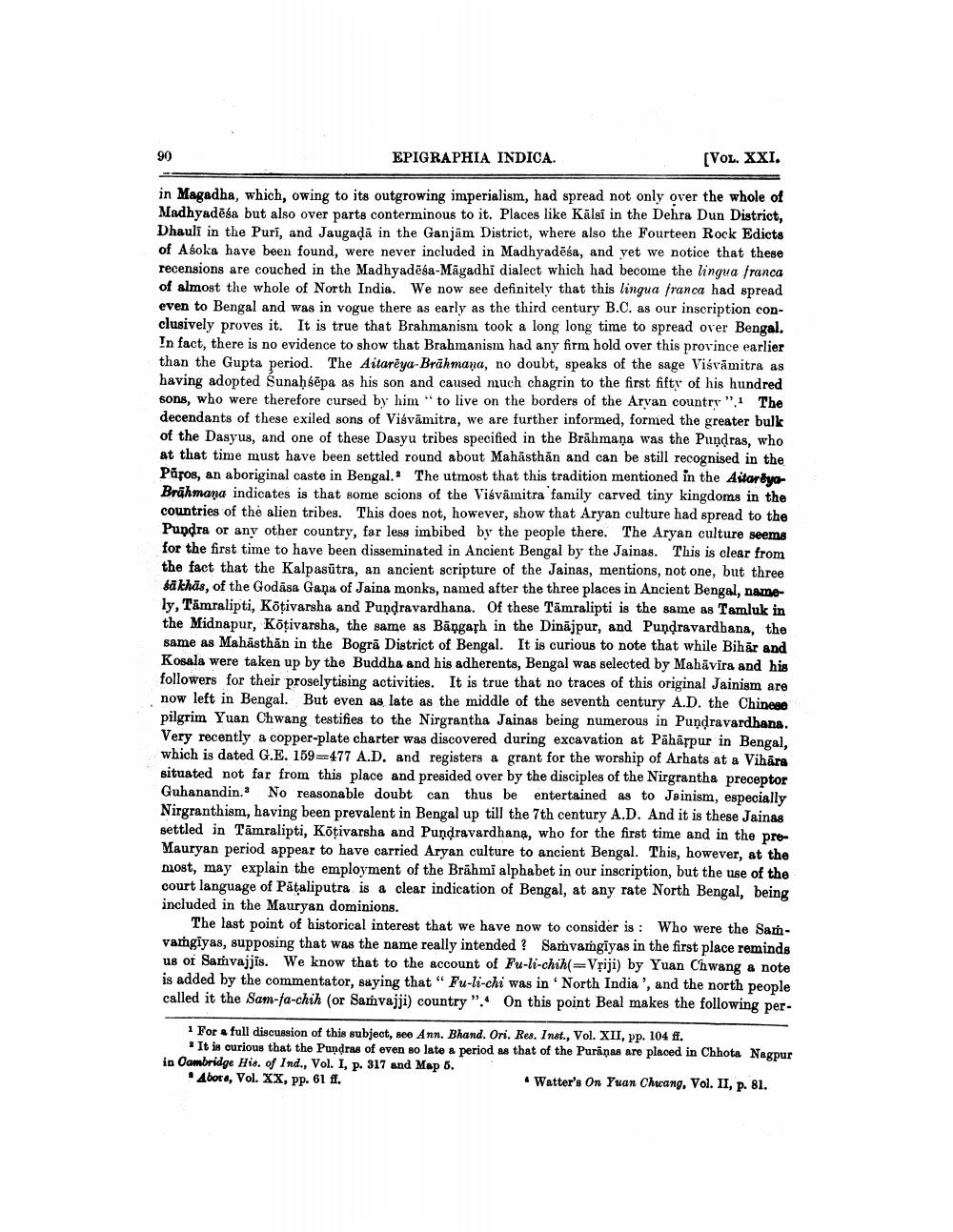________________
90
EPIGRAPHIA INDICA.
[VOL. XXI.
in Magadha, which, owing to its outgrowing imperialism, had spread not only over the whole of Madhyadoba but also over parts conterminous to it. Places like Kälsi in the Dehra Dun District, Dhauli in the Puri, and Jaugada in the Ganjām District, where also the Fourteen Rock Edicts of Asoka have been found, were never included in Madhyadēśa, and yet we notice that these recensions are couched in the Madhyadēša-Māgadhi dialect which had become the lingua franca of almost the whole of North India. We now see definitely that this lingua franca had spread even to Bengal and was in vogue there as early as the third century B.C. as our inscription conclusively proves it. It is true that Brahmanism took a long long time to spread over Bengal. In fact, there is no evidence to show that Brahmanism had any firm hold over this province earlier than the Gupta period. The Aitarëya-Bräkmana, no doubt, speaks of the sage Viśvāmitra as having adopted Sunaḥśēpa as his son and caused much chagrin to the first fifty of his hundred sons, who were therefore cursed by him "to live on the borders of the Aryan country", The decendants of these exiled sons of Visvämitra, we are further informed, formed the greater bulk of the Dasyus, and one of these Dasyu tribes specified in the Brahmana was the Pundras, who at that time must have been settled round about Mahästhān and can be still recognised in the Pūpos, an aboriginal caste in Bengal. The utmost that this tradition mentioned in the AitariyaBrāhmaṇa indicates is that some scions of the Visvämitra family carved tiny kingdoms in the countries of the alien tribes. This does not, however, show that Aryan culture had spread to the Pundra or any other country, far less imbibed by the people there. The Aryan culture seems for the first time to have been disseminated in Ancient Bengal by the Jainas. This is clear from the fact that the Kalpasūtra, an ancient scripture of the Jainas, mentions, not one, but three sākhās, of the Godāsa Gana of Jaina monks, named after the three places in Ancient Bengal, namely, Tamralipti, Kotivarsha and Pundravardhana. Of these Tāmralipti is the same as Tamluk in the Midnapur, Köțivarsha, the same as Bangaph in the Dinājpur, and Pundravardhana, the same as Mahästhan in the Bogra District of Bengal. It is curious to note that while Bihär and Kosala were taken up by the Buddha and his adherents, Bengal was selected by Mahävira and his followers for their proselytising activities. It is true that no traces of this original Jainism are now left in Bengal. But even as late as the middle of the seventh century A.D. the Chinese pilgrim Yuan Chwang testifies to the Nirgrantha Jainas being numerous in Pundravardhana. Very recently a copper-plate charter was discovered during excavation at Pāhāļpur in Bengal, which is dated G.E. 159477 A.D. and registers a grant for the worship of Arhats at a Vihara situated not far from this place and presided over by the disciples of the Nirgrantha preceptor Guhanandin. No reasonable doubt can thus be entertained as to Jainism, especially Nirgranthism, having been prevalent in Bengal up till the 7th century A.D. And it is these Jainas settled in Tāmralipti, Köțivarsha and Pundravardhana, who for the first time and in the proMauryan period appear to have carried Aryan culture to ancient Bengal. This, however, at the most, may explain the employment of the Brāhmi alphabet in our inscription, but the use of the court language of Pataliputra is a clear indication of Bengal, at any rate North Bengal, being included in the Mauryan dominions.
The last point of historical interest that we have now to consider is : Who were the Samvamgiyas, supposing that was the name really intended ? Samvangiyas in the first place reminds us of Samvajjis. We know that to the account of Fu-li-chih(=Vriji) by Yuan Chwang & note is added by the commentator, saying that “Fu-li-chi was in North India', and the north people called it the Sam-fa-chih (or Samvajji) country". On this point Beal makes the following per
1 For a full discussion of this subject, see Ann. Bhand. Ori. Res. Inst., Vol. XII, pp. 104 ff.
. It is ourious that the Pundras of even so late a period as that of the Puranas are placed in Chhota Nagpur in Cambridge His. of Ind., Vol. I, p. 317 and Map 8. *Abora, Vol. XX, pp. 61 ff.
• Watter's On Yuan Chuang, Vol. II, p. 81.




